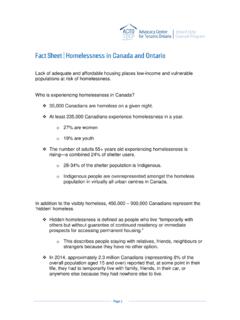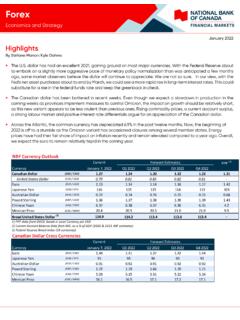Transcription of Seizing the Opportunities for Hydrogen
1 Seizing the Opportunities for Hydrogen A Call to Action December, 2020 Hydrogen STRATEGY FOR CANADA DISCLAIMER The Hydrogen Strategy for Canada (the Strategy ) provides the perspective of numerous stakeholders from across governments, and industry, as well as Indigenous organizations, non-governmental organizations, and academia. While the Government of Canada led the development of the Strategy and consulted broadly with industry, the contents, findings, and recommendations expressed in the Strategy reflects a combined view and may not be unanimously endorsed by all of the participating organizations and their employees. Aussi disponible en fran ais sous le titre : Strat gie canadienne pour l hydrog ne Cat. No. M134-65/2020E-PDF (Online) ISBN 978-0-660-36760-6 Foreword to the Hydrogen Strategy for Canada | Pg. I Foreword to the Hydrogen Strategy for Canada For more than a century, our nation s brightest minds have been working on the technology to turn the invisible promise of Hydrogen into tangible solutions.
2 canadian ingenuity and innovation has once again brought us to a pivotal moment. As we rebuild our economy from the impacts of COVID-19 and fight the existential threat of climate change, the development of low-carbon Hydrogen is a strategic priority for Canada. The time to act is now. The Hydrogen Strategy for Canada lays out an ambitious framework for actions that will cement Hydrogen as a tool to achieve our goal of net-zero emissions by 2050 and position Canada as a global, industrial leader of clean renewable fuels. This strategy shows us that by 2050, clean Hydrogen can help us achieve our net-zero goal all while creating jobs, growing our economy, and protecting our environment. This will involve switching from conventional gasoline, diesel, and natural gas to zero-emissions fuel sources, taking advantage of new regulatory environments, and embracing new technologies to give Canadians more choice of zero emission alternatives.
3 As one of the top 10 Hydrogen producers in the world today, we are rich in the feedstocks that produce Hydrogen . We are blessed with a strong energy sector, and the geographic assets that will propel Canada to be a major exporter of Hydrogen and Hydrogen technologies. Hydrogen might be nature s smallest molecule but its potential is enormous. It provides new markets for our conventional energy resources, and holds the potential to decarbonize many sectors of our economy, including resource extraction, freight, transportation, power generation, manufacturing, and the production of steel and cement. This Strategy is a call to action. It will spur investments and strategic partnerships across the country and beyond our borders. It will position Canada to seize economic and environmental Opportunities that exist coast to coast. Expanding our exports. Creating as many as 350,000 good, green jobs over the next three decades. All while dramatically reducing our greenhouse gas emissions.
4 And putting a net-zero future within our reach. The importance of Canada s resource industries and our clean technology sectors has been magnified during the pandemic. We must harness our combined will, expertise and financial resources to fully seize the Opportunities that Hydrogen presents. This strategy is the product of three years of study and analysis, including extensive engagement sessions, where we heard from more than 1,500 of our country s leading experts and stakeholders. But its release is not the end of a process. This is only the beginning. Together, we will use this Strategy to guide our actions and investments. By working with provinces and territories, Indigenous partners, and the private-sector and by leveraging our many advantages, we will create the prosperity we all want, protect the planet we all cherish and we will ensure we leave no one behind. The Honourable Seamus O Regan Canada s Minister of Natural Resources Contributors | Pg. II Contributors For the past three years, the Government of Canada, under the leadership of Natural Resources Canada, has been working with private sector stakeholders, Indigenous organizations, non-Government organizations, and governments at all levels to inform the development of a Hydrogen Strategy for Canada.
5 This Strategy contains input from hundreds of companies, organizations and individuals sourced through a variety of different forums, workshops, teleconferences, bilateral discussions, and dialogue through existing working groups. While the Government of Canada led the development of the Strategy and consulted broadly with industry, the contents, findings, and recommendations expressed in the Strategy reflects a combined view and may not be unanimously endorsed by all of the participating organizations and their employees. The Government has also commissioned a number of key studies on topics such as Hydrogen codes and standards, awareness, demand modelling, and GHG emissions reduction potential. These studies along with key international reports, for example from the International Energy Agency and Hydrogen Council, have helped inform the development of the Strategy. Zen and the Art of Clean Energy Solutions (Zen) is the lead author of this strategy on behalf of the Government of Canada.
6 Zen together with the Institute for Breakthrough Energy + Emission Technologies (IBET) led the aggregated 2050 Hydrogen demand modelling work to determine the potential role Hydrogen can play in Canada s future energy system. The Strategy summarizes and integrates stakeholder inputs and previous studies, as well as recent modelling and analysis, into a single cohesive document. The Hydrogen Strategy for Canada is a strategic directional document based on best available information at this time. Adjustments will be made as technology, research, codes and standards, the international Hydrogen landscape, and policy evolves. Additional research and analysis outlined as recommended actions in this document are planned through the Implementation Strategic Steering Committee, dedicated Working Groups, and Regional Blueprints. Consultations Consultations were held with over 1,500 stakeholders from across the value chain to ensure engagement Opportunities were as comprehensive as possible.
7 Stakeholder groups include, but are not limited to the private sector, associations and NGOs, academia and research groups, Federal and Provincial Governments, and Indigenous Organizations, communities, and businesses. Linkages with Industry Working Groups The Government has also collaborated closely with the Transition Accelerator, the canadian Hydrogen and Fuel Cell Association (CHFCA), the canadian Gas Association, and other industry associations which are pursuing actions closely aligned with those identified in the Strategy. Once the strategy is released, Canada will establish a Strategic Steering Committee, with several targeted task teams, to ensure progress toward the recommendations in the strategy is made and measured. Abbreviations | Pg. III Abbreviations AHJ Authority Having Jurisdiction ASHP Air Source Heat Pump ATR Autothermal Reforming AZETEC Alberta Zero-Emissions Truck Electrification Collaboration BC-LCFS British Columbia s Low Carbon Fuel Standard BECCS Bio-energy with Carbon Capture and Storage BEV Battery Electric Vehicle BNQ Bureau de Normalization du Qu bec CAD canadian Dollars CCUS Carbon Capture Utilization, Storage CEC California Energy Commission CFS Clean Fuel Standard CHFCA canadian Hydrogen and Fuel Cell Association CHIC canadian Hydrogen Installation Code CI Carbon Intensity CMMP canadian Minerals and Metals Plan CNG Compressed Natural Gas CO Carbon Monoxide CO2 Carbon Dioxide CSA canadian Standards Association DAC Direct Air Capture DOE Department of Energy (US)
8 DRI Direct Reduced Iron EER Energy Effectiveness Ratio FCEB Fuel Cell Electric Bus FCEV Fuel Cell Electric Vehicle GDP Gross Domestic Product GHG Greenhouse Gas GJ Gigajoule GW Gigawatt H2 Hydrogen HD Heavy-Duty ICE Internal Combustion Engine ICT Innovative Clean Transit IEA International Energy Agency IMO IP International Maritime Organization Intellectual Property IRAP Industrial Research Assistance Program LD Light-Duty LNG Liquid Natural Gas MCH Methylcyclohexane MJ Megajoule NG Natural Gas NH3 Ammonia NOx Nitrogen Oxides NRC National Research Council Abbreviations | Pg. IV OEM Original Equipment Manufacturer OpEx Operating Expenditures PEM Proton Exchange Membrane PJ Petajoules PSA Pressure Swing Adsorption RNG Renewable Natural Gas SMR Steam Methane Reforming SOEC Solid Oxide Electrolysis Cell SOx Sulphur Oxides SR&ED Scientific Research and Experimental Development Tax Incentive Program SDTC Sustainable Development Technology Canada TCO Total Cost of Ownership TRL Technology Readiness Level TWh VRE Terawatt-hour Variable Renewable Energy WGS Water Gas Shift ZEV Zero-Emission Vehicle Contents | Pg.
9 V Contents Foreword to the Hydrogen Strategy for Canada .. I Contributors .. II Abbreviations .. III Executive Summary .. VIII 1. Why Hydrogen in Canada .. 1 Canada s Advantages .. 3 Our unique starting point .. 7 Hydrogen at scale delivers real benefits for 10 2. What is Hydrogen ? .. 13 Hydrogen Fundamentals .. 13 Global Momentum for Clean Hydrogen .. 16 3. Canada s Production & Distribution Opportunities .. 19 Production Pathways .. 19 Canada s Regional Hydrogen Production Resources .. 32 Production Pathways Cost & Carbon Intensity .. 34 Hydrogen Storage & Distribution .. 39 4. Hydrogen End-Use Opportunities .. 44 Fuel for Transportation .. 45 Fuel for Power Generation .. 57 Heat for Industry & Buildings .. 59 Feedstock for 64 5. Putting it All Together: Canada s Hydrogen Opportunity .. 69 Hydrogen as Part of an Integrated Energy System in Canada .. 69 Rollout Timing & 72 Quantifying the 76 Hydrogen s Decarbonization Potential .. 82 Economic Opportunity .. 84 6.
10 Opportunities Beyond Our Borders .. 88 Export Market .. 88 Target Markets .. 89 Enablers .. 92 7. Remaining Challenges .. 96 Economic & Investment .. 96 Technology & 97 Policy & Regulation .. 97 Hydrogen & 97 Codes & Standards .. 98 Awareness .. 98 8. Seizing Canada s Hydrogen 99 Vision for 2050 ..100 Roadmap to 2050 ..101 Time to Act ..104 Contents | Pg. VI LIST OF FIGURES Figure 1 Why Hydrogen in Canada? .. 1 Figure 2 Canada's Starting Point for Low-CI Hydrogen Production and Use .. 9 Figure 3 Canada s 2017 GHG Emission InventoryError! Bookmark not defined.. 12 Figure 4 What is Hydrogen ? .. 13 Figure 5 Key Benefits of Using Hydrogen .. 14 Figure 6 Hydrogen Value Chain .. 15 Figure 7 Global Hydrogen Production by Energy Source (2018)1 .. 16 Figure 8 Global Hydrogen Demand by End-Use (2018)1 .. 16 Figure 9 Ranges of Estimates for Annual Global Hydrogen 17 Figure 10 International Momentum on Hydrogen .. 18 Figure 11 Hydrogen Production Pathways in Canada.

















